Barack Obama
| Barack Obama | |
|---|---|
 |
|
| 44th President of the United States | |
| Assumed office January 20, 2009 |
|
| Vice President | Joe Biden |
| Preceded by | George W. Bush |
| United States Senator from Illinois |
|
| In office January 3, 2005 – November 16, 2008 |
|
| Preceded by | Peter Fitzgerald |
| Succeeded by | Roland Burris |
| Member of the Illinois Senate from the 13th district |
|
| In office January 8, 1997 – November 4, 2004 |
|
| Preceded by | Alice Palmer |
| Succeeded by | Kwame Raoul |
| Personal details | |
| Born | Barack Hussein Obama II August 4, 1961 Honolulu, Hawaii, U.S. |
| Nationality | American |
| Political party | Democratic |
| Spouse(s) | Michelle Robinson (m. 1992) |
| Children | Malia Sasha |
| Residence | White House |
| Education | Punahou School |
| Alma mater |
|
| Religion | Protestantism (see details)[1] |
| Signature | |
| Website | barackobama |
 |
This article is part of a series about Barack Obama |
|---|---|
|
President of the United States Incumbent First Term Second Term |
|
In 2004, Obama received national attention during his campaign to represent Illinois in the United States Senate with his victory in the March Democratic Party primary, his keynote address at the Democratic National Convention in July, and his election to the Senate in November. He began his presidential campaign in 2007 and, after a close primary campaign against Hillary Rodham Clinton in 2008, he won sufficient delegates in the Democratic Party primaries to receive the presidential nomination. He then defeated Republican nominee John McCain in the general election, and was inaugurated as president on January 20, 2009. Nine months after his inauguration, Obama was named the 2009 Nobel Peace Prize laureate.
During his first two years in office, Obama signed into law economic stimulus legislation in response to the Great Recession in the form of the American Recovery and Reinvestment Act of 2009 and the Tax Relief, Unemployment Insurance Reauthorization, and Job Creation Act of 2010. Other major domestic initiatives in his first term included the Patient Protection and Affordable Care Act, often referred to as "Obamacare"; the Dodd–Frank Wall Street Reform and Consumer Protection Act; and the Don't Ask, Don't Tell Repeal Act of 2010. In foreign policy, Obama ended U.S. military involvement in the Iraq War, increased U.S. troop levels in Afghanistan, signed the New START arms control treaty with Russia, ordered U.S. military involvement in Libya in opposition to Muammar Gaddafi, and ordered the military operation that resulted in the death of Osama bin Laden. In January 2011, the Republicans regained control of the House of Representatives as the Democratic Party lost a total of 63 seats; and, after a lengthy debate over federal spending and whether or not to raise the nation's debt limit, Obama signed the Budget Control Act of 2011 and the American Taxpayer Relief Act of 2012.
Obama was reelected president in November 2012, defeating Republican nominee Mitt Romney, and was sworn in for a second term on January 20, 2013. During his second term, Obama has promoted domestic policies related to gun control in response to the Sandy Hook Elementary School shooting, and has called for greater inclusiveness for LGBT Americans, while his administration has filed briefs which urged the Supreme Court to strike down part of the federal Defense of Marriage Act and state level same-sex marriage bans as unconstitutional. In foreign policy, Obama ordered U.S. military intervention in Iraq in response to gains made by the Islamic State after the 2011 withdrawal from Iraq, continued the process of ending U.S. combat operations in Afghanistan, and normalized U.S. relations with Cuba.
Early life and career
Main articles: Family of Barack Obama and Early life and career of Barack Obama
Obama was born on August 4, 1961,[2] at Kapiʻolani Maternity & Gynecological Hospital (now Kapiʻolani Medical Center for Women and Children) in Honolulu, Hawaii,[3][4][5] and would become the first President to have been born in Hawaii.[6] His mother, Stanley Ann Dunham, born in Wichita, Kansas, was of mostly English ancestry.[7] His father, Barack Obama, Sr., was a Luo from Nyang’oma Kogelo, Kenya. Obama's parents met in 1960 in a Russian language class at the University of Hawaiʻi at Mānoa, where his father was a foreign student on scholarship.[8][9] The couple married in Wailuku on Maui on February 2, 1961,[10][11] and separated when, in late August 1961, Obama's mother moved with their newborn son to attend the University of Washington
in Seattle for a year. During that time, Obama, Sr. completed his
undergraduate economics degree in Hawaii in June 1962, then left to
attend graduate school at Harvard University on a scholarship. Obama's parents divorced in March 1964.[12] Obama Sr. returned to Kenya in 1964 where he remarried; he visited Barack in Hawaii only once, in 1971.[13] He died in an automobile accident in 1982, his son being 21 years old at that time.[14]In 1963, Dunham met Lolo Soetoro, an Indonesian East–West Center graduate student in geography at the University of Hawaii, and the couple were married on Molokai on March 15, 1965.[15] After two one-year extensions of his J-1 visa, Lolo returned to Indonesia in 1966, followed sixteen months later by his wife and stepson in 1967, with the family initially living in a Menteng Dalam neighborhood in the Tebet subdistrict of south Jakarta, then from 1970 in a wealthier neighborhood in the Menteng subdistrict of central Jakarta.[16] From ages six to ten, Obama attended local Indonesian-language schools: St. Francis of Assisi Catholic School for two years and Besuki Public School for one and a half years, supplemented by English-language Calvert School homeschooling by his mother.[17]
Obama with his half-sister Maya Soetoro-Ng, mother Ann Dunham and grandfather Stanley Dunham, in Honolulu, Hawaii
Of his early childhood, Obama recalled, "That my father looked nothing like the people around me—that he was black as pitch, my mother white as milk—barely registered in my mind."[9] He described his struggles as a young adult to reconcile social perceptions of his multiracial heritage.[22] Reflecting later on his years in Honolulu, Obama wrote: "The opportunity that Hawaii offered—to experience a variety of cultures in a climate of mutual respect—became an integral part of my world view, and a basis for the values that I hold most dear."[23] Obama has also written and talked about using alcohol, marijuana, and cocaine during his teenage years to "push questions of who I was out of my mind".[24] Obama was also a member of the "choom gang", a self-named group of friends that spent time together and occasionally smoked marijuana.[25][26]
After high school, Obama moved to Los Angeles in 1979 to attend Occidental College. In February 1981, Obama made his first public speech, calling for Occidental to participate in the disinvestment from South Africa in response to that nation's policy of apartheid.[27] In mid-1981, Obama traveled to Indonesia to visit his mother and half-sister Maya, and visited the families of college friends in Pakistan and India for three weeks.[27] Later in 1981, he transferred as a junior to Columbia College, Columbia University, in New York City, where he majored in political science with a specialty in international relations[28] and lived off-campus on West 109th Street.[29] He graduated with a BA degree in 1983 and worked for a year at the Business International Corporation,[30] then at the New York Public Interest Research Group.[31][32] In 1985, Obama was among the leaders of May Day efforts to bring attention to the New York City Subway system, which was in a bad condition at the time. Obama traveled to several subway stations to get people to sign letters addressed to local officials and the Metropolitan Transportation Authority, and was photographed at the City College subway station holding a sign protesting against the system's condition.[33]
Community organizer and Harvard Law School
Two years after graduating, Obama was hired in Chicago as director of the Developing Communities Project, a church-based community organization originally comprising eight Catholic parishes in Roseland, West Pullman, and Riverdale on Chicago's South Side. He worked there as a community organizer from June 1985 to May 1988.[32][34] He helped set up a job training program, a college preparatory tutoring program, and a tenants' rights organization in Altgeld Gardens.[35] Obama also worked as a consultant and instructor for the Gamaliel Foundation, a community organizing institute.[36] In mid-1988, he traveled for the first time in Europe for three weeks and then for five weeks in Kenya, where he met many of his paternal relatives for the first time.[37][38] He returned to Kenya in 1992 with his fiancée Michelle and his half-sister Auma,[37][39] and again in August 2006 for a visit to his father's birthplace, a village near Kisumu in rural western Kenya.[40]Obama entered Harvard Law School in the fall of 1988. He was selected as an editor of the Harvard Law Review at the end of his first year,[41] president of the journal in his second year,[35][42] and research assistant to the constitutional scholar Laurence Tribe while at Harvard for two years.[43] During his summers, he returned to Chicago, where he worked as an associate at the law firms of Sidley Austin in 1989 and Hopkins & Sutter in 1990.[44] After graduating with a JD degree magna cum laude[45] from Harvard in 1991, he returned to Chicago.[41] Obama's election as the first black president of the Harvard Law Review gained national media attention[35][42] and led to a publishing contract and advance for a book about race relations,[46] which evolved into a personal memoir. The manuscript was published in mid-1995 as Dreams from My Father.[46]
University of Chicago Law School and civil rights attorney
In 1991, Obama accepted a two-year position as Visiting Law and Government Fellow at the University of Chicago Law School to work on his first book.[46][47] He then taught constitutional law at the University of Chicago Law School for twelve years, first as a Lecturer from 1992 to 1996, and then as a Senior Lecturer from 1996 to 2004.[48]From April to October 1992, Obama directed Illinois's Project Vote, a voter registration campaign with ten staffers and seven hundred volunteer registrars; it achieved its goal of registering 150,000 of 400,000 unregistered African Americans in the state, leading Crain's Chicago Business to name Obama to its 1993 list of "40 under Forty" powers to be.[49]
He joined Davis, Miner, Barnhill & Galland, a 13-attorney law firm specializing in civil rights litigation and neighborhood economic development, where he was an associate for three years from 1993 to 1996, then of counsel from 1996 to 2004. In 1994, he was listed as one of the lawyers in Buycks-Roberson v. Citibank Fed. Sav. Bank, 94 C 4094 (N.D. Ill.).[50] This class action lawsuit was filed in 1994 with Selma Buycks-Roberson as lead plaintiff and alleged that Citibank Federal Savings Bank had engaged in practices forbidden under the Equal Credit Opportunity Act and the Fair Housing Act.[51] The case was settled out of court.[52] Final Judgment was issued on May 13, 1998 with Citibank Federal Savings Bank agreeing to pay attorney fees.[53] His law license became inactive in 2007.[54][55]
From 1994 to 2002, Obama served on the boards of directors of the Woods Fund of Chicago, which in 1985 had been the first foundation to fund the Developing Communities Project, and of the Joyce Foundation.[32] He served on the board of directors of the Chicago Annenberg Challenge from 1995 to 2002, as founding president and chairman of the board of directors from 1995 to 1999.[32]
Legislative career, 1997–2008
Illinois State Senator (1997–2004)
Main article: Illinois Senate career of Barack Obama
Obama and others celebrate the naming of a street in Chicago after ShoreBank co-founder Milton Davis in 1998
He was reelected to the Illinois Senate in 1998, defeating Republican Yesse Yehudah in the general election, and was reelected again in 2002.[60] In 2000, he lost a Democratic primary race for Illinois's 1st congressional district in the United States House of Representatives to four-term incumbent Bobby Rush by a margin of two to one.[61]
In January 2003, Obama became chairman of the Illinois Senate's Health and Human Services Committee when Democrats, after a decade in the minority, regained a majority.[62] He sponsored and led unanimous, bipartisan passage of legislation to monitor racial profiling by requiring police to record the race of drivers they detained, and legislation making Illinois the first state to mandate videotaping of homicide interrogations.[58][63] During his 2004 general election campaign for U.S. Senate, police representatives credited Obama for his active engagement with police organizations in enacting death penalty reforms.[64] Obama resigned from the Illinois Senate in November 2004 following his election to the U.S. Senate.[65]
2004 U.S. Senate campaign
Main article: United States Senate election in Illinois, 2004
County results of the 2004 U.S. Senate race in Illinois. Obama won the counties in blue.
Obama was an early opponent of the George W. Bush administration's 2003 invasion of Iraq.[67] On October 2, 2002, the day President Bush and Congress agreed on the joint resolution authorizing the Iraq War,[68] Obama addressed the first high-profile Chicago anti-Iraq War rally,[69] and spoke out against the war.[70] He addressed another anti-war rally in March 2003 and told the crowd that "it's not too late" to stop the war.[71]
Decisions by Republican incumbent Peter Fitzgerald and his Democratic predecessor Carol Moseley Braun to not participate in the election resulted in wide-open Democratic and Republican primary contests involving fifteen candidates.[72] In the March 2004 primary election, Obama won in an unexpected landslide—which overnight made him a rising star within the national Democratic Party, started speculation about a presidential future, and led to the reissue of his memoir, Dreams from My Father.[73] In July 2004, Obama delivered the keynote address at the 2004 Democratic National Convention,[74] seen by 9.1 million viewers. His speech was well received and elevated his status within the Democratic Party.[75]
Obama's expected opponent in the general election, Republican primary winner Jack Ryan, withdrew from the race in June 2004.[76] Six weeks later, Alan Keyes accepted the Republican nomination to replace Ryan.[77] In the November 2004 general election, Obama won with 70 percent of the vote.[78]
U.S. Senator from Illinois (2005–08)
Main article: United States Senate career of Barack Obama
Obama in his official portrait as a member of the United States Senate
Legislation
Obama cosponsored the Secure America and Orderly Immigration Act.[82] He introduced two initiatives that bore his name: Lugar–Obama, which expanded the Nunn–Lugar Cooperative Threat Reduction concept to conventional weapons;[83] and the Federal Funding Accountability and Transparency Act of 2006, which authorized the establishment of USAspending.gov, a web search engine on federal spending.[84] On June 3, 2008, Senator Obama—along with Senators Tom Carper, Tom Coburn, and John McCain—introduced follow-up legislation: Strengthening Transparency and Accountability in Federal Spending Act of 2008.[85]Obama sponsored legislation that would have required nuclear plant owners to notify state and local authorities of radioactive leaks, but the bill failed to pass in the full Senate after being heavily modified in committee.[86] Regarding tort reform, Obama voted for the Class Action Fairness Act of 2005 and the FISA Amendments Act of 2008, which grants immunity from civil liability to telecommunications companies complicit with NSA warrantless wiretapping operations.[87]
Obama and U.S. Sen. Richard Lugar (R-IN) visit a Russian facility for dismantling mobile missiles (August 2005)[88]
Later in 2007, Obama sponsored an amendment to the Defense Authorization Act to add safeguards for personality-disorder military discharges.[93] This amendment passed the full Senate in the spring of 2008.[94] He sponsored the Iran Sanctions Enabling Act supporting divestment of state pension funds from Iran's oil and gas industry, which has not passed committee; and co-sponsored legislation to reduce risks of nuclear terrorism.[95] Obama also sponsored a Senate amendment to the State Children's Health Insurance Program, providing one year of job protection for family members caring for soldiers with combat-related injuries.[96]
Committees
Obama held assignments on the Senate Committees for Foreign Relations, Environment and Public Works and Veterans' Affairs through December 2006.[97] In January 2007, he left the Environment and Public Works committee and took additional assignments with Health, Education, Labor, and Pensions and Homeland Security and Governmental Affairs.[98] He also became Chairman of the Senate's subcommittee on European Affairs.[99] As a member of the Senate Foreign Relations Committee, Obama made official trips to Eastern Europe, the Middle East, Central Asia and Africa. He met with Mahmoud Abbas before Abbas became President of the Palestinian National Authority, and gave a speech at the University of Nairobi in which he condemned corruption within the Kenyan government.[100]Presidential campaigns
2008 presidential campaign
Main articles: United States presidential election, 2008, Barack Obama presidential primary campaign, 2008 and Barack Obama presidential campaign, 2008
Obama stands on stage with his wife and daughters just before announcing his presidential candidacy in Springfield, Illinois, February 10, 2007
Numerous candidates entered the Democratic Party presidential primaries. The field narrowed to a duel between Obama and Senator Hillary Clinton after early contests, with the race remaining close throughout the primary process but with Obama gaining a steady lead in pledged delegates due to better long-range planning, superior fundraising, dominant organizing in caucus states, and better exploitation of delegate allocation rules.[106] On June 7, 2008, Clinton ended her campaign and endorsed Obama.[107]
President George W. Bush meets with President-elect Obama in the Oval Office on November 10, 2008
During both the primary process and the general election, Obama's campaign set numerous fundraising records, particularly in the quantity of small donations.[113] On June 19, 2008, Obama became the first major-party presidential candidate to turn down public financing in the general election since the system was created in 1976.[114]
John McCain was nominated as the Republican candidate, and the two engaged in three presidential debates in September and October 2008.[115] On November 4, Obama won the presidency with 365 electoral votes to 173 received by McCain.[116] Obama won 52.9 percent of the popular vote to McCain's 45.7 percent.[117] He became the first African American to be elected president.[118] Obama delivered his victory speech before hundreds of thousands of supporters in Chicago's Grant Park.[119]
2012 presidential campaign
Main articles: United States presidential election, 2012 and Barack Obama presidential campaign, 2012
Former Governor Mitt Romney and President Barack Obama shake hands in the Oval Office on November 29, 2012, following their first meeting since President Obama's reelection
At the Democratic National Convention in Charlotte, North Carolina, Obama and Joe Biden were formally nominated by former President Bill Clinton, as the Democratic Party candidates for president and vice president in the general election. Their main opponents were Republicans Mitt Romney, the former governor of Massachusetts, and Representative Paul Ryan of Wisconsin.[125]
On November 6, 2012, Obama won 332 electoral votes, exceeding the 270 required for him to be reelected as president.[126][127][128] With 51.1 percent of the popular vote,[129] Obama became the first Democratic president since Franklin D. Roosevelt to twice win the majority of the popular vote.[130][131] President Obama addressed supporters and volunteers at Chicago's McCormick Place after his reelection and said: "Tonight you voted for action, not politics as usual. You elected us to focus on your jobs, not ours. And in the coming weeks and months, I am looking forward to reaching out and working with leaders of both parties."[132][133]
Presidency (2009–present)
Main article: Presidency of Barack Obama
See also: Confirmations of Barack Obama's Cabinet and List of presidential trips made by Barack Obama
First days
Barack Obama takes the oath of office administered by Chief Justice John G. Roberts Jr. at the Capitol, January 20, 2009
Domestic policy
Main article: Barack Obama social policy
The first bill signed into law by Obama was the Lilly Ledbetter Fair Pay Act of 2009, relaxing the statute of limitations for equal-pay lawsuits.[142]
Five days later, he signed the reauthorization of the State Children's
Health Insurance Program (SCHIP) to cover an additional 4 million
uninsured children.[143] In March 2009, Obama reversed a Bush-era policy which had limited funding of embryonic stem cell research and pledged to develop "strict guidelines" on the research.[144]
Obama delivering a speech at joint session of Congress with Vice President Joe Biden and House Speaker Nancy Pelosi on February 24, 2009
On September 30, 2009, the Obama administration proposed new regulations on power plants, factories and oil refineries in an attempt to limit greenhouse gas emissions and to curb global warming.[148][149]
On October 8, 2009, Obama signed the Matthew Shepard and James Byrd, Jr. Hate Crimes Prevention Act, a measure that expands the 1969 United States federal hate-crime law to include crimes motivated by a victim's actual or perceived gender, sexual orientation, gender identity, or disability.[150][151]
On March 30, 2010, Obama signed the Health Care and Education Reconciliation Act, a reconciliation bill which ends the process of the federal government giving subsidies to private banks to give out federally insured loans, increases the Pell Grant scholarship award, and makes changes to the Patient Protection and Affordable Care Act.[152][153]
In a major space policy speech in April 2010, Obama announced a planned change in direction at NASA, the U.S. space agency. He ended plans for a return of human spaceflight to the moon and development of the Ares I rocket, Ares V rocket and Constellation program, in favor of funding Earth science projects, a new rocket type, and research and development for an eventual manned mission to Mars, and ongoing missions to the International Space Station.[154]
Obama meets with the Cabinet, November 23, 2009
LGBT Rights
On December 22, 2010, Obama signed the Don't Ask, Don't Tell Repeal Act of 2010, fulfilling a key promise made in the 2008 presidential campaign[157][158] to end the Don't ask, don't tell policy of 1993 that had prevented gay and lesbian people from serving openly in the United States Armed Forces.[159]As a candidate for the Illinois state senate Obama had said in 1996 that he favored legalizing same-sex marriage;[160] but by the time of his run for the U.S. senate in 2004, he said that while he supported civil unions and domestic partnerships for same-sex partners, for strategic reasons he opposed same-sex marriages.[161] On May 9, 2012, shortly after the official launch of his campaign for reelection as president, Obama said his views had evolved, and he publicly affirmed his personal support for the legalization of same-sex marriage, becoming the first sitting U.S. president to do so.[162][163]
During his second inaugural address on January 21, 2013,[133] Obama called for full equality for gay Americans: "Our journey is not complete until our gay brothers and sisters are treated like anyone else under the law—for if we are truly created equal, then surely the love we commit to one another must be equal as well." This was a historic moment, being the first time that a president mentioned gay rights or the word "gay" in an inaugural address.[164][165] In 2013, the Obama administration filed briefs urging the Supreme Court to rule in favor of same-sex couples in the cases of Hollingsworth v. Perry (regarding same-sex marriage)[166] and United States v. Windsor (regarding the Defense of Marriage Act).[167] Then, following the Supreme's Courts decision about same-sex marriage in June 2015, Obama asserted that "This decision affirms what millions of Americans already believe in their hearts: When all Americans are treated as equal we are all more free."[168]
White House advisory and oversight groups
On March 11, 2009, Obama created the White House Council on Women and Girls, which forms part of the Office of Intergovernmental Affairs, having been established by Executive Order 13506 with a broad mandate to advise him on issues relating to the welfare of American women and girls.[169] The Council is currently chaired by Senior Advisor to the President Valerie Jarrett.[170] Obama also established the White House Task Force to Protect Students from Sexual Assault through an official United States government memorandum on January 22, 2014 with a broad mandate to advise him on issues relating to sexual assault on college and university campuses throughout the United States.[170][171][172] The current co-chairs of the Task Force are Vice President Joe Biden and Jarrett.[171] The Task Force has been a development out of the White House Council on Women and Girls and Office of the Vice President of the United States, and prior to that, the 1994 Violence Against Women Act that was first-drafted by Biden.[173]Economic policy
Main article: Economic policy of Barack Obama
Obama presents his first weekly address as President of the United States on January 24, 2009, discussing the American Recovery and Reinvestment Act of 2009
In March, Obama's Treasury Secretary, Timothy Geithner, took further steps to manage the financial crisis, including introducing the Public-Private Investment Program for Legacy Assets, which contains provisions for buying up to two trillion dollars in depreciated real estate assets.[176] Obama intervened in the troubled automotive industry[177] in March 2009, renewing loans for General Motors and Chrysler to continue operations while reorganizing. Over the following months the White House set terms for both firms' bankruptcies, including the sale of Chrysler to Italian automaker Fiat[178] and a reorganization of GM giving the U.S. government a temporary 60 percent equity stake in the company, with the Canadian government taking a 12 percent stake.[179] In June 2009, dissatisfied with the pace of economic stimulus, Obama called on his cabinet to accelerate the investment.[180] He signed into law the Car Allowance Rebate System, known colloquially as "Cash for Clunkers", that temporarily boosted the economy.[181][182][183]
Spending and loan guarantees from the Federal Reserve and the Treasury Department authorized by the Bush and Obama administrations totaled about $11.5 trillion, but only $3 trillion was spent by the end of November 2009.[184] Obama and the Congressional Budget Office predicted the 2010 budget deficit would be $1.5 trillion or 10.6 percent of the nation's gross domestic product (GDP) compared to the 2009 deficit of $1.4 trillion or 9.9 percent of GDP.[185][186] For 2011, the administration predicted the deficit will slightly shrink to $1.34 trillion, while the 10-year deficit will increase to $8.53 trillion or 90 percent of GDP.[187] The most recent increase in the U.S. debt ceiling to $17.2 trillion took effect in February 2014.[188] On August 2, 2011, after a lengthy congressional debate over whether to raise the nation's debt limit, Obama signed the bipartisan Budget Control Act of 2011. The legislation enforces limits on discretionary spending until 2021, establishes a procedure to increase the debt limit, creates a Congressional Joint Select Committee on Deficit Reduction to propose further deficit reduction with a stated goal of achieving at least $1.5 trillion in budgetary savings over 10 years, and establishes automatic procedures for reducing spending by as much as $1.2 trillion if legislation originating with the new joint select committee does not achieve such savings.[189] By passing the legislation, Congress was able to prevent a U.S. government default on its obligations.[190]
Employment statistics (changes in unemployment rate and net jobs per month) during Obama's tenure as U.S. President[191][192]
The Congressional Budget Office and a broad range of economists credit Obama's stimulus plan for economic growth.[201][202] The CBO released a report stating that the stimulus bill increased employment by 1–2.1 million,[202][203][204][205] while conceding that "It is impossible to determine how many of the reported jobs would have existed in the absence of the stimulus package."[201] Although an April 2010 survey of members of the National Association for Business Economics showed an increase in job creation (over a similar January survey) for the first time in two years, 73 percent of 68 respondents believed that the stimulus bill has had no impact on employment.[206] The economy of the United States has grown faster than the other original NATO members by a wider margin under President Obama than it has anytime since the end of World War II.[207] The OECD credits the much faster growth in the United States to the stimulus in the United States and the austerity measures in the European Union.[208]
Within a month of the 2010 midterm elections, Obama announced a compromise deal with the Congressional Republican leadership that included a temporary, two-year extension of the 2001 and 2003 income tax rates, a one-year payroll tax reduction, continuation of unemployment benefits, and a new rate and exemption amount for estate taxes.[209] The compromise overcame opposition from some in both parties, and the resulting $858 billion Tax Relief, Unemployment Insurance Reauthorization, and Job Creation Act of 2010 passed with bipartisan majorities in both houses of Congress before Obama signed it on December 17, 2010.[210]
In December 2013, Obama declared that growing income inequality is a "defining challenge of our time" and called on Congress to bolster the safety net and raise wages. This came on the heels of the nationwide strikes of fast-food workers and Pope Francis' criticism of inequality and trickle-down economics.[211]
Environmental policy
In July 2013, Obama expressed reservations and stated he "would reject the Keystone XL pipeline if it increased carbon pollution" or "greenhouse emissions".[214][215] Obama's advisers called for a halt to petroleum exploration in the Arctic in January 2013.[216] On February 24, 2015, Obama vetoed a bill that would authorize the pipeline.[217] It was the third veto of Obama's presidency and his first major veto.[218]
Health care reform
Main article: Health care reform in the United States
Obama signs the Patient Protection and Affordable Care Act at the White House, March 23, 2010
On July 14, 2009, House Democratic leaders introduced a 1,017-page plan for overhauling the U.S. health care system, which Obama wanted Congress to approve by the end of 2009.[219] After much public debate during the Congressional summer recess of 2009, Obama delivered a speech to a joint session of Congress on September 9 where he addressed concerns over the proposals.[222] In March 2009, Obama lifted a ban on using federal funds for stem cell research.[223]
Maximum Out-of-Pocket Premium as Percentage of Family Income and federal poverty level, under Patient Protection and Affordable Care Act, starting in 2014 (Source: CRS)[224]
The ACA includes health-related provisions to take effect over four years, including expanding Medicaid eligibility for people making up to 133 percent of the federal poverty level (FPL) starting in 2014,[230] subsidizing insurance premiums for people making up to 400 percent of the FPL ($88,000 for family of four in 2010) so their maximum "out-of-pocket" payment for annual premiums will be from 2 to 9.5 percent of income,[231][232] providing incentives for businesses to provide health care benefits, prohibiting denial of coverage and denial of claims based on pre-existing conditions, establishing health insurance exchanges, prohibiting annual coverage caps, and support for medical research. According to White House and Congressional Budget Office figures, the maximum share of income that enrollees would have to pay would vary depending on their income relative to the federal poverty level.[231][233]
The costs of these provisions are offset by taxes, fees, and cost-saving measures, such as new Medicare taxes for those in high-income brackets, taxes on indoor tanning, cuts to the Medicare Advantage program in favor of traditional Medicare, and fees on medical devices and pharmaceutical companies;[234] there is also a tax penalty for those who do not obtain health insurance, unless they are exempt due to low income or other reasons.[235] In March 2010, the Congressional Budget Office estimated that the net effect of both laws will be a reduction in the federal deficit by $143 billion over the first decade.[236]
The law faced several legal challenges, primarily based on the argument that an individual mandate requiring Americans to buy health insurance was unconstitutional. On June 28, 2012, the Supreme Court ruled by a 5–4 vote in National Federation of Independent Business v. Sebelius that the Commerce Clause does not allow the government to require people to buy health insurance, but the mandate was constitutional under the U.S. Congress's taxing authority.[237] In Burwell v. Hobby Lobby the Court ruled that "closely-held" for-profit corporations could be exempt on religious grounds under the Religious Freedom Restoration Act from regulations adopted under the ACA that would have required them to pay for insurance that covered certain contraceptives.
Energy policy
Main article: Energy policy of the Obama administration
Prior to June 2014, Obama offered substantial support for a broadly
based "All of the above" approach to domestic energy policy which Obama
has maintained since his first term and which he last confirmed at his
State of the Union speech in January 2014 to a mixed reception by both
parties. In June 2014, Obama made indications that his administration
would consider a shift towards an energy policy more closely tuned to
the manufacturing industry and its impact on the domestic economy.[238]
Obama's approach of selectively combining regulation and incentive to
various issues in the domestic energy policy such as coal mining and oil
fracking has received mixed commentary for not being as responsive to
the needs of the domestic manufacturing sector as needed, following
claims that the domestic manufacturing sector utilizes as much as a
third of nation's available energy resources.[239][240]Gun control
President Obama at University of Colorado Hospital visiting 2012 Aurora shooting victims
2010 midterm elections
Main articles: United States House of Representatives elections, 2010 and United States Senate elections, 2010
Obama called the November 2, 2010 election, where the Democratic Party lost 63 seats in, and control of, the House of Representatives,[243] "humbling" and a "shellacking".[244] He said that the results came because not enough Americans had felt the effects of the economic recovery.[245]Cybersecurity and Internet policy
On November 10, 2014, President Obama recommended the Federal Communications Commission reclassify broadband Internet service as a telecommunications service in order to preserve net neutrality.[246][247]On February 12, 2013, President Obama signed Executive Order 13636, "Improving Critical Infrastructure Cybersecurity". The Executive Order is designed to increase the level of core capabilities for our critical infrastructure to manage cyber risk. It does this by focusing on three key areas: (1) information sharing, (2) privacy, and (3) the adoption of cybersecurity practices.[248]
Foreign policy
Main article: Foreign policy of the Barack Obama administration
Obama speaking on "A New Beginning" at Cairo University on June 4, 2009
NAFTA leaders Canadian Prime Minister Stephen Harper, Mexican President Peña Nieto, and U.S. President Barack Obama, 2014
On March 19, Obama continued his outreach to the Muslim world, releasing a New Year's video message to the people and government of Iran.[251][252] In April, Obama gave a speech in Ankara, Turkey, which was well received by many Arab governments.[253] On June 4, 2009, Obama delivered a speech at Cairo University in Egypt calling for "A New Beginning" in relations between the Islamic world and the United States and promoting Middle East peace.[254]
On June 26, 2009, in response to the Iranian government's actions towards protesters following Iran's 2009 presidential election, Obama said: "The violence perpetrated against them is outrageous. We see it and we condemn it."[255] On July 7, while in Moscow, he responded to a Vice President Biden comment on a possible Israeli military strike on Iran by saying: "We have said directly to the Israelis that it is important to try and resolve this in an international setting in a way that does not create major conflict in the Middle East."[256]
On September 24, 2009, Obama became the first sitting U.S. president to preside over a meeting of the United Nations Security Council.[257]
In March 2010, Obama took a public stance against plans by the government of Israeli Prime Minister Benjamin Netanyahu to continue building Jewish housing projects in predominantly Arab neighborhoods of East Jerusalem.[258][259] During the same month, an agreement was reached with the administration of Russian President Dmitry Medvedev to replace the 1991 Strategic Arms Reduction Treaty with a new pact reducing the number of long-range nuclear weapons in the arsenals of both countries by about one-third.[260] Obama and Medvedev signed the New START treaty in April 2010, and the U.S. Senate ratified it in December 2010.[261]
In December 2011, Obama instructed agencies to consider LGBT rights when issuing financial aid to foreign countries.[262] He criticized Russia's law discriminating against gays in August 2013,[263] stopping short of advocating a boycott of the 2014 Winter Olympics held in Sochi, Russia.[264]
In December 2014, Obama announced that he intended to normalize relationships between Cuba and the United States.[265] The countries' respective "interests sections" in one another's capitals were upgraded to embassies on July 20, 2015.
War in Iraq
Main articles: Iraq War and American-led intervention in Iraq (2014–present)
On February 27, 2009, Obama announced that combat operations in Iraq
would end within 18 months. His remarks were made to a group of Marines
preparing for deployment to Afghanistan. Obama said, "Let me say this
as plainly as I can: by August 31, 2010, our combat mission in Iraq will
end."[266]
The Obama administration scheduled the withdrawal of combat troops to
be completed by August 2010, decreasing troop's levels from 142,000
while leaving a transitional force of about 50,000 in Iraq until the end
of 2011. On August 19, 2010, the last U.S. combat brigade exited Iraq.
Remaining troops transitioned from combat operations to counter-terrorism and the training, equipping, and advising of Iraqi security forces.[267][268] On August 31, 2010, Obama announced that the United States combat mission in Iraq was over.[269] On October 21, 2011 President Obama announced that all U.S. troops would leave Iraq in time to be "home for the holidays".[270]In June 2014, following the capture of Mosul by the Islamic State of Iraq and the Levant (ISIL), Obama sent 275 troops to provide support and security for U.S. personnel and the U.S. Embassy in Baghdad. ISIL continued to gain ground and to commit widespread massacres and ethnic cleansing.[271][272]
In August 2014, during the Sinjar massacre, Obama ordered a campaign of U.S. airstrikes against ISIL.[273]
By the end of 2014, 3,100 American ground troops were committed to the conflict[274] and 16,000 sorties were flown over the battlefield, primarily by U.S. Air Force and Navy pilots.[275]
In the Spring of 2015 with the addition of the "Panther Brigade" of the 82nd Airborne Division the number of U.S. ground troops in Iraq surged to 4,400[276] and by July American-led coalition air forces counted 44,000 sorties over the battlefield.[277]
Meeting with British Prime Minister David Cameron during the 2010 G-20 Toronto summit
War in Afghanistan
Main article: War in Afghanistan (2001–present)
Early in his presidency, Obama moved to bolster U.S. troop strength in Afghanistan.[278]
He announced an increase to U.S. troop levels of 17,000 in February
2009 to "stabilize a deteriorating situation in Afghanistan", an area he
said had not received the "strategic attention, direction and resources
it urgently requires".[279] He replaced the military commander in Afghanistan, General David D. McKiernan, with former Special Forces commander Lt. Gen. Stanley A. McChrystal
in May 2009, indicating that McChrystal's Special Forces experience
would facilitate the use of counterinsurgency tactics in the war.[280]
On December 1, 2009, Obama announced the deployment of an additional
30,000 military personnel to Afghanistan and proposed to begin troop
withdrawals 18 months from that date;[281] this took place in July 2011. David Petraeus replaced McChrystal in June 2010, after McChrystal's staff criticized White House personnel in a magazine article.[282]
In February 2013, Obama said the U.S. military would reduce the troop
level in Afghanistan from 68,000 to 34,000 U.S. troops by February 2014.[283]Israel
Obama meeting with Israeli President Shimon Peres, 2009
In June 2012, Obama said that the bond between the United States and Israel is "unbreakable."[286] During the initial years of the Obama administration, the U.S. increased military cooperation with Israel, including increased military aid, re-establishment of the U.S.-Israeli Joint Political Military Group and the Defense Policy Advisory Group, and an increase in visits among high-level military officials of both countries.[287] The Obama administration asked Congress to allocate money toward funding the Iron Dome program in response to the waves of Palestinian rocket attacks on Israel.[288]
In 2013, Jeffrey Goldberg reported that, in Obama's view, "with each new settlement announcement, Netanyahu is moving his country down a path toward near-total isolation."[289]
In 2014, President Obama likened the Zionist movement to the Civil Rights Movement in the United States. He said that both movements seek to bring justice and equal rights to historically persecuted peoples. He explained, "To me, being pro-Israel and pro-Jewish is part and parcel with the values that I’ve been fighting for since I was politically conscious and started getting involved in politics."[290]
War in Libya
Main article: 2011 military intervention in Libya
In March 2011, as forces loyal to Muammar Gaddafi advanced on rebels across Libya, calls for a no-fly zone came from around the world, including Europe, the Arab League, and a resolution[291] passed unanimously by the U.S. Senate.[292] In response to the unanimous passage of United Nations Security Council Resolution 1973 on March 17, Gaddafi—who had previously vowed to "show no mercy" to the rebels of Benghazi[293]—announced an immediate cessation of military activities,[294]
yet reports came in that his forces continued shelling Misrata. The
next day, on Obama's orders, the U.S. military took part in air strikes
to destroy the Libyan government's air defense capabilities to protect
civilians and enforce a no-fly-zone,[295] including the use of Tomahawk missiles, B-2 Spirits, and fighter jets.[296][297][298] Six days later, on March 25, by unanimous vote of all of its 28 members, NATO took over leadership of the effort, dubbed Operation Unified Protector.[299] Some Representatives[300]
questioned whether Obama had the constitutional authority to order
military action in addition to questioning its cost, structure and
aftermath.[301][302]Osama bin Laden
Main article: Death of Osama bin Laden
|
|
|
| Problems playing these files? See media help. | |
President Barack Obama along with members of the national security team, receive an update on Operation Neptune's Spear, in the White House Situation Room, May 1, 2011. See also: The Situation Room (photograph)
Cultural and political image
Main article: Public image of Barack Obama
See also: International media reaction to the United States presidential election, 2008 and International reactions to the United States presidential election, 2012
Obama's first term presidential portrait (2009)
Obama is frequently referred to as an exceptional orator.[327] During his pre-inauguration transition period and continuing into his presidency, Obama has delivered a series of weekly Internet video addresses.[328]
Obama conducting the first completely virtual interview from the White House in 2012[329]
In a February 2009 poll conducted in Western Europe and the U.S. by Harris Interactive for France 24 and the International Herald Tribune, Obama was rated as the most respected world leader, as well as the most powerful.[341] In a similar poll conducted by Harris in May 2009, Obama was rated as the most popular world leader, as well as the one figure most people would pin their hopes on for pulling the world out of the economic downturn.[342][343]
G8 leaders watching the 2012 UEFA Champions League Final
On October 9, 2009, the Norwegian Nobel Committee announced that Obama had won the 2009 Nobel Peace Prize "for his extraordinary efforts to strengthen international diplomacy and cooperation between peoples".[351] Obama accepted this award in Oslo, Norway on December 10, 2009, with "deep gratitude and great humility."[352] The award drew a mixture of praise and criticism from world leaders and media figures.[353][354][355][356][357][358][359] Obama's peace prize was called a "stunning surprise" by The New York Times.[360] Obama is the fourth U.S. president to be awarded the Nobel Peace Prize and the third to become a Nobel laureate while in office.[361] Obama's Nobel Prize has been viewed skeptically in subsequent years, especially after the director of the Nobel Institute, Geir Lundestad, said Obama's Peace Prize was a "failure".[362]
Family and personal life
Main article: Family of Barack Obama
Obama posing in the Green Room of the White House with wife Michelle and daughters Sasha and Malia in 2009
Besides his native English, Obama speaks some basic Indonesian, having learned the language during his four childhood years in Jakarta.[369][370] He plays basketball, a sport he participated in as a member of his high school's varsity team;[371] he is left-handed.[372]
Obama taking a shot during a game on the White House


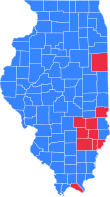


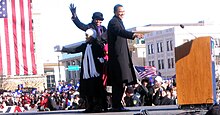


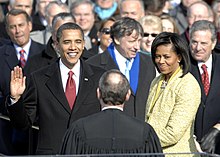
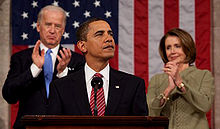
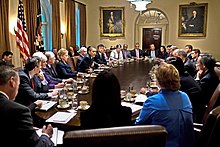
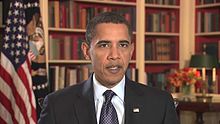


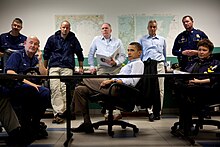
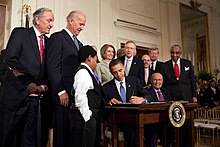






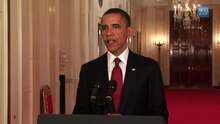
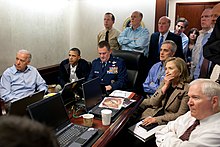



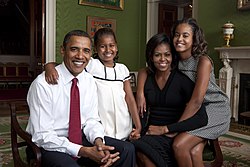

No comments:
Post a Comment